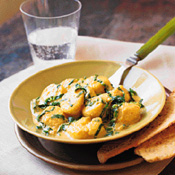|
|
Cuisine Glossary
| You have reached our International Cuisines and information on all aspects of a countries cuisine.
We will try to explain the culture, significant influences, climate, and other factors that have come together to create a distinct style. For example: Spanish, Mexican or Japanese. |
Indonesian Cuisine
 |
Indonesia's indigenous techniques and ingredients merge with influences from India, the Middle East, China and Europe. And then there are the New World products brought by Spanish and Portuguese traders long before the Dutch colonized the islands.
Aficionados can only skim the surface unless we travel Indonesia itself. Most restaurants abroad and English-language cookbooks focus on the foods of Java and Sumatra with tastes of tourist-haven Bali. But the cuisines on these islands alone provide us with plenty of opportunity to keep our taste buds happy and our tongues tingling. Rice is Indonesia's main staple except in Maluku (the Moluccas) and Irian Jaya (Indonesian New Guinea) where sago palm flour, sweet potatoes and cassava reign supreme. As in the rest of Southeast Asia, other dishes are eaten in extremely small quantities. Meat, fish and vegetables are condiments designed to flavor the staple. Sauces such as fiery sambals lend added character. Westerners, accustomed to eating much larger portions of meat and fish, find much of Indonesian food scorchingly hot. Source: Nancy Freeman |




